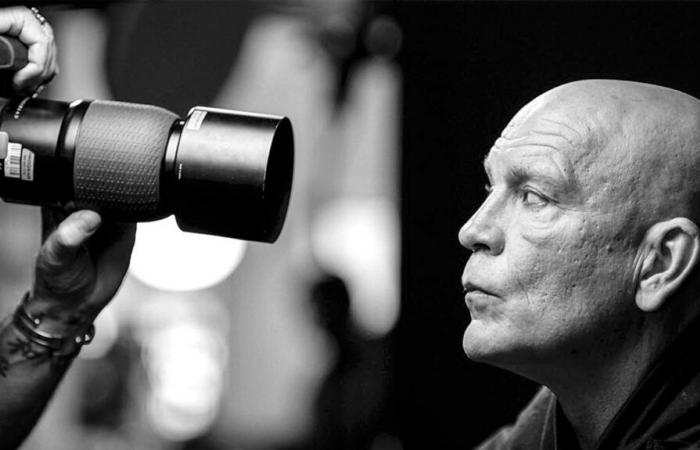“In 1997, a man walked through the doors of my studio in Chicago and changed my career,” says American photographer Sandro Miller. That man was actor John Malkovich.
“John gave me the freedom to create and use my knowledge as a photographer to explore and push the boundaries, both in photography and cinema. »
This creative playground is revealed in Malkovich : Then Came Johnthe latest book featuring Sandro's “muse.” Yet it is much more than a collection of extraordinary photographs taken over three decades. It is the story of the meeting of two inspired minds. Crazy, improbable and sometimes almost impossible artistic feats brought to life, and friendship and collaboration that endures across time and space.
The two men met when Chicago's Steppenwolf Theater Company commissioned Sandro to photograph Malkovich. Thinking back to this first meeting, Sandro remembers that the photo session took place around the time of the release of the film Con Air. “John had played this horrible, murderous sociopath, Cyrus “the Virus” who literally scared most of us. He played the character with such perfection that I imagined he could look like this maniac,” he laughs. “Wow, I was really wrong. John entered the studio, alone, without entourage, without manager. I remember meeting him at the door, each of us extending our hands in greeting. In a soft and kind voice, he introduced himself. He was the antithesis of the Con Air character. Open and curious, kind and accommodating, Malkovich exuded none of the pretensions that Sandro had experienced with other celebrities.
Since then, they have met several times, with Malkovich offering Sandro a “blank canvas”. In truth, I didn’t really know if I would ever have the chance to work with John again,” reveals Sandro. “Deep down, it was just a crazy dream to think about having John as a muse. » As Sandro's Malkovich-inspired work asserts, dreams come true.
Malkovich worked with Sandro on projects influenced by Plato to the work of filmmaker David Lynch. The most famous collaboration is Malkovich, Malkovich, Malkovich : Homage to Photographic Mastersa collection of iconic 20th century photographs recreated by Sandro, an unprecedented artistic feat. Another work featured in the new book comes from the short film Psychogenic Fuguein which Sandro shows Malkovich playing eight eclectic characters from Lynch's films, including Frank Booth and Elephant Man. There are also selections from other projects, including Frolic and Frantic.
In Then Came, John Malkovich writes: “I am delighted to have had the opportunity and great pleasure to collaborate with him (Sandro) on so many different and exciting projects. He is a fantastic colleague and friend, a great storyteller and a wonderfully gifted seeker and discoverer of truth.
In a Zoom interview with Malkovich, who is currently in Bulgaria directing a play, the actor tells me that after the first shoot with Sandro, he was ready to do more. “I just discovered that I really liked his ideas, his notions that were funny and strange and beautifully photographed and incredibly well researched and thoughtful. His ideas are very original, very inventive. These are not things I would have imagined.
When asked how he perceives his role in their collaborations, Malkovich returns to Homagethe epic project he worked on with Sandro for several years, an idea that came to Sandro while he was undergoing treatment for stage four cancer over a decade ago.
“I’m a figure in someone else’s dream,” Malkovich says. “These are Sandro's ideas and he is very clear about what he wants… It's not just about the physical manifestation of the photo… he's a great director, eliciting what he wants to see from the 'inside the photo, the aura. ” It's this last point that Malkovich emphasizes, explaining that Sandro's ability to convey and capture the quintessence of the character in the frame is where the real craft lies. That's also part of the appeal of working together, with Sandro's ability to articulate his vision merging with Malkovich's talent for evoking another's identity.
While Malkovich's respect for Sandro is obvious, it's also clear that he enjoys the creative process. The artistic vision may be Sandro's, but Malkovich reveals he loves getting involved in hair and makeup. I ask him why and he smiles. “Well that's a great question, no one has asked me that question before. »
“I think even before the first wink, that’s where you win or lose. You're giving an impression of a character and how that character exists in the world, moves through the world. What does the viewer see? Physically, in this first second, even millisecond, do they see Salvador Dali or not? And if not, why not? If someone's facial structure is so different from mine, how can I get there? And what compromises do we have to make to get there, and how do we hide the fact that we have made compromises? »
He continues. “Those are really fascinating questions for me, as far as I'm concerned – and it's not actors' language – it's really about the image and what an image conveys. I worked with Randy Wilder, who did the makeup for all of these photos. Randy and I would sit and chat and and we'd go like okay, do I do this, and I'd get some wax and do a nose job, something I could never do on film. Creating the nose showed us what other things we needed to highlight or cover… I find this process very interesting because I love drawing and painting. When I first look at the picture, and I'm in the makeup chair, and Randy and I each have a makeup pencil or stick (to draw on the face), I think, wow, this doesn't look good not be so easy, but it's a big problem to solve. » As he speaks, his eyes shine. It’s obvious he’s fascinated by the process.
Malkovich shares that one of the most difficult images to recreate was Victor Skrebneski's portrait of Bette Davis. “I’m not a very small woman and I don’t have big eyes,” he laughs. “Bette Davis, who I flew with centuries ago, was small and her eyes were huge. »
And his portrait Tribute favorite ? Malkovich does not hesitate. “Diane Arbus’s twins. It's just an extremely provocative and profound statement about twins, about little girls, about how they perceive themselves and how they are perceived, what they present to the world and their concern for each other. »
The Making of Then Came John
The idea of Malkovich : Then Came John was born from Sandro's friend and art collector, Duncan Meeder in the Netherlands, who collaborated with Steven Hond of Komma (No Ordinary Publisher).
“These two crazy dreamers created something extraordinary, an art object rather than a commercial book, a collector’s item,” says Sandro. Limited to 300 copies, the book features a selection of photographs from various Sandro/Malkovich projects. In a first, an LED screen has been integrated into the cover and fifty images of Malkovich's eyes play in rotation. Signed by Sandro and Malkovich, the book comes with a specially designed steel stand, a USB stick containing four short films and a portrait of Malkovich created especially for this edition.
Then Came John also features remarkable behind-the-scenes footage that conveys the scale of the work and the intense research and meticulous planning required to recreate iconic portraits such as the masterpieces ofTribute. In a world of Photoshop and, increasingly, AI, Sandro's dedication to working in camera shows his extraordinary commitment to the art of traditional portrait photography. The painstaking reconstruction of every element of the original image, down to period costumes and lighting, offers a unique insight into the working spirit of this innovative photographer. These photographs are possible thanks to Sandro's passion for perfecting his craft. In this respect, Sandro and Malkovich are of the same ilk.
Nearly 30 years after their first meeting, the Sandro/Malkovich partnership has produced nearly 250 photographs, as well as an award-winning short film. Malkovich shares that he is open to whatever inspired ideas Sandro comes up with next. “I love working with Sandro. Anything can happen if he has a new idea.”
As for Sandro, his passion for his muse is intact. The motivation is simple. “I come back to John because of his talent but also because he holds a special place in my heart.”
Alison Stieven-Taylor
Malkovich: Then Came John
352 pages / 35.5 x 45 cm
Copies: 300
ISBN: 978-90-833673-6-1
Come Publishing






